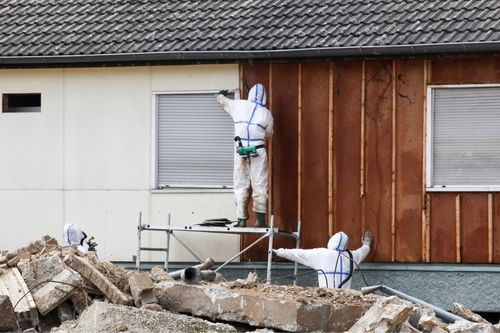Throughout the mid twentieth century, asbestos was commonly used throughout the homebuilding process. It was typically used as insulation, but would also pop up in vinyl flooring, cement siding, walls, pipes—you name it. After it was discovered that inhaling asbestos fibers has serious health effects, its domestic production slowed, and legislation was put forth to ban it altogether.
However, just like lead paint, homes that were built in the asbestos era still carry a dormant risk. If your home contains asbestos, you should be aware of its dangers, how to handle it, and how to go about removing it safely.
How to Handle Asbestos in Your Home
Having asbestos material in your home is not inherently hazardous if the material is left undisturbed. So, if your asbestos material is intact and in good condition, the best thing to do is to leave it be. However, the moment asbestos material becomes damaged—either from degrading over time or because of a sudden accident—it becomes dangerous. Once asbestos fibers are released, it can spell trouble for you and your household.
Testing for Asbestos
If you find damaged asbestos material, you should cordon off the area to the best of your ability to limit exposure. If restricting the area means you could disturb the asbestos, then it’s best to refrain from interacting with it and let a professional handle it.
DIY asbestos testing is possible, but it can be highly toxic if you don’t take the proper precautions. An asbestos inspector will conduct a thorough examination of your home to determine the extent of its presence and provide their recommended course of action. It is advised to test for asbestos before making an addition or a large-scale remodel to your home.

Image Source: Getty Images – Image Credit: ricochet64
Removing Asbestos
You can either repair existing asbestos exposure or have it removed. Repairs can be cheaper in the short term but may simply be prolonging the inevitable. Making repairs on your own is generally not recommended, since the slightest mishandling of the exposed asbestos can create a much bigger problem.
When it comes to removing asbestos, you’ll want to enlist the help of a professional. As with any contractor, ask for quotes and make comparisons before deciding who you’ll hire. Before the job is finalized, have your home tested to ensure that all asbestos has been safely removed from the premises.
For more tips on home safety, home maintenance, and avoiding dangers caused by the systems in your home, read our blog post on How to Prevent and Deal with Mold.
Featured Image Source: Getty Images – Image Credit: BanksPhotos
 Facebook
Facebook
 X
X
 Pinterest
Pinterest
 Copy Link
Copy Link
